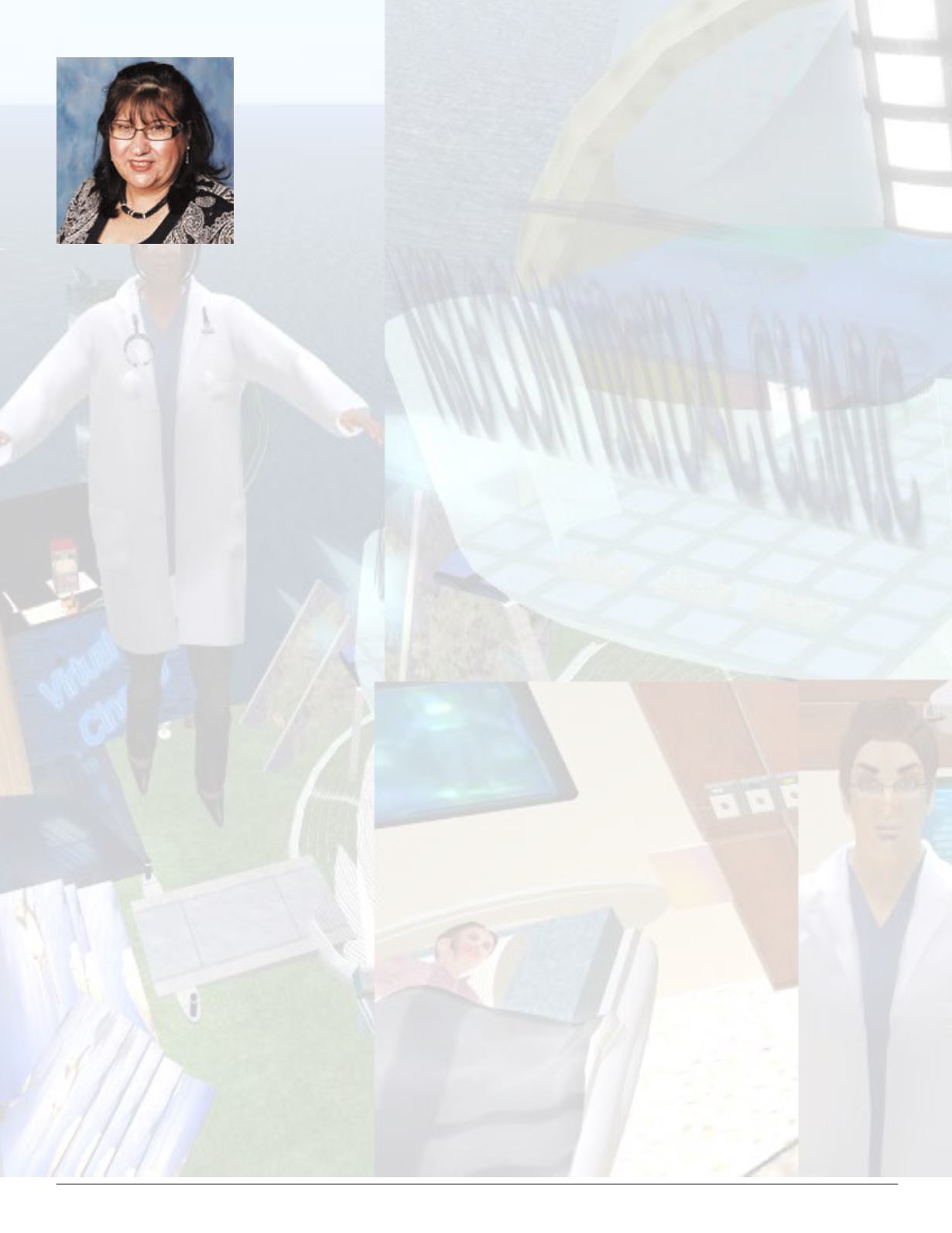
15
COM Outlook . Fall 2013
FACULTY PERSPECTIVE
Embracing the Future Via
Virtual World Technology
By Marti Echols, Ph.D., M.Ed.
Assistant Dean of Medical Education
What Is Virtual World?
Second Life (SL) virtual world is a
tool that is enhancing socialization and
social presence in distance learning by
providing students and teachers a new
way to interact, collaborate, and engage,
in addition to learning by doing. Virtual
world is a Web-enabled, computer-
based, and simulated multimedia loca-
tion where users can reside, socialize,
and interact as avatars; however, virtual
worlds are built for different purposes.
These human-controlled avatars live
in virtual-land regions and act the same
as their human counterparts in other
social networks. While in Second Life,
which is owned by Linden Labs, resi-
dents are free to do whatever they want;
however, when used for educational
purposes, it must be structured with
well-defined goals and objectives.
How it All Began
It was during a holiday break three
years ago that I was watching my grand-
daughter play on my computer. She was
so involved in what she was doing, so I
sat next to her to discover what had fas-
cinated her. She was in a virtual world
and had created an avatar of herself. She
was
shopping
at designer outlet malls,
changing outfits, and checking to see
how she looked. I became enthralled and
soon found myself as an avatar, flying
around the virtual world visiting all
kinds of unique places.
(Who knew I could
be a blue-eyed blonde?)
As I played in virtual world, the idea
that NSU-COM could build a virtual
clinic, have student doctors be the ava-
tars, and use the clinic to practice clinical
skills was born. I spent a good deal
of time exploring the availabilities of
virtual worlds in the fields of health care
and education. To my surprise, no one
was actually doing it. After presenting
the idea to our medical education team
members, they ventured into virtual
world and began exploring.
Our goal was to provide an innova-
tive instructional tool where our medical
students could perform a realistic virtual
encounter with patients. This would
allow students to simulate patient care
at any time and from anywhere as they
reinforced didactic and clinical-skills ex-
periences in a safe environment without
risks to real patients.
The next step involved investigation
into such tasks as how to obtain land,
buy a
sandbox
(parcel of land), and pur-
chase items in virtual world. We discov-
ered NSU had purchased land in Second
Life, so the I-Zone graciously donated
a sandbox on which we could build the
clinic’s physical structure. The follow-
ing year, with budgeted funds, we built
the clinic structure and bought clinical
equipment and supplies to create the
individual physician clinic rooms.
Like all construction projects, it took
more time than planned, but we did stay
within our budget. Using students from
the M.S. in Medical Education degree
program, we tested the project. The stu-
dents then made themselves avatars and
moved throughout the clinic, providing
us with excellent feedback to improve
the clinic environment and suggesting
the virtual world clinic would be the
perfect environment to practice interpro-
fessional patient care.
NSU-COM and Virtual World
The first educational project in the
NSU-COM Virtual Clinic was to rein-
force the clinical skills experience of
medical students during the Patient-Cen-
tered Medicine course. The first clinical
scenario created was to assess the ability
of our second-year medical students to
ask correct, open-ended questions dur-
ing a virtual encounter with patients in
the SL virtual world. The student doctors
create their avatars and then fly in-world
for a virtual patient encounter.
Upon arriving at the virtual clinic, the
student doctor is presented with a brief
orientation and proceeds to the clinic
room. As the student doctor walks into
the room, the virtual patient presents
with certain conditions. The student doc-
tor interacts with the virtual patient by
attempting to ask the patient open-ended
questions. Once the correct, open-ended
question is asked, the student gets im-
mediate feedback. This process ensures
timely feedback and debriefing and com-
pletes the simulated experience.
The virtual Art Observation Center is
the second educational project in virtual
world, which involves art from the NSU
Museum of Art Fort Lauderdale being
used for a Web module called “Art,
Medicine, and Observation.” The goal
of the virtual art gallery is to provide
third- and fourth-year medical students
with a flexible instructional medium to
use during the course. The scenarios the
student doctors are presented during
the course involve having the virtual
patients present with conditions the
students can diagnose by relating them
to what they have learned from the art
observation session.
The Future of Virtual World
This cutting-edge instructional
technology, which is unique in the field
of health care and education, enhances
communication and sharing—a crucial
feature needed in e-health care educa-
tion. Students and professors could meet
in-world at any time and from anywhere
to discuss projects, make presentations,
do group projects, and share resources
by conducting clinical skills experiences
in this simulated environment without
posing risks to the actual patient. Student
advising and mentoring could also benefit
from this modality. It also has promise
as a significant platform for health care
coaching, especially for patients who
need chronic disease management.
SL could foster visualization of global
research work and meetings, where
experts would meet in-world to discuss
their collaborative work, educate, social-
ize, and interact with one another in a
risk-free environment while simulating
real-life experience. The NSU-COM Vir-
tual Clinic and Art Observation Center,
developed for structured educational
purposes, is the first of its kind in the
nation. We are proud that NSU-COM
is leading the way as we continue our
tradition of High Touch, High Tech™
medical education.


